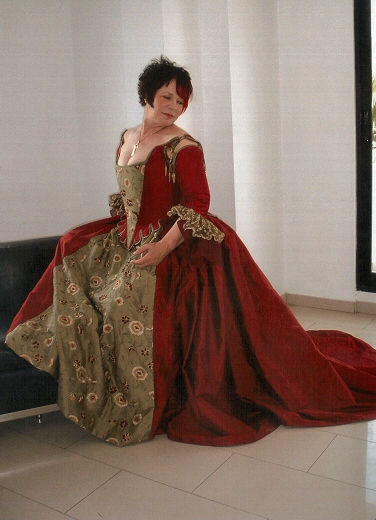 Introduction and
Introduction and
Information
(Home)
Home 2
FAQ/Contacts
Pre-Raphaelite
& Mediaeval
Contemporary
Bridal Gowns
Corsets/Stays
The William Morris
Collection
Classical Tutus
& Dance Costume
16th and 17th Century
18th and 19th Century
Ready-to-Wear
Accessories
Design Process
Sample Sale
Experience
File
|
|
| 18th
Corset, Skirt & Hooded Cloak |
"Flora" |

|
| Teresa's stunning red silk gown was partly inspired by two beautifully toning fabrics - an olive green silk embroidered with cut velvet flowers (available in six alternative colourways) and a red/black plain silk. The gown consists of a classic eighteenth century style boned corset (view the corset category on the menu for similar shapes) with tie-on / detatchable sleeves and a cartridge pleated skirt worn over a bum-roll, providing an enviable silhouette. |
| The main corset and skirt were constructed in a deep red/ black silk dupion with the contrasting embroidered fabric used as a stomacher front to the bodice and an apron front to the skirt.
A hooded cloak, shown in a soft sage green velvet, was designed to tone with the 18th century style gown. It was lined in red silk dupion. The double sleeve falls of lace and organza at the cuff give an authentic 18th century feel. The waist tabs are bound by hand in the contrasting olive green silk colour - toning with the embroidered fabric. The lacing at the back of the corset ensures it fits like a glove. Original design sketch with alternative styling.
A similar 18th century style corset approx: £700 - £850; similar skirts from £1000; cloak from £450 Accurate costs can only be verified after a consultation and fabric choices.
N.B. It is not obligatory to include foundation garments such as bum-rolls with period gowns or for wedding gowns based on period shapes. However, subtly positioned padding will reliably provide the appropriate profile of the period, so that at a glance a gown will look "right". These "supports" can vary in size from tiny pads, worn at the back of the waist for a classic "Austen Era" gown - just enough to support folds of muslin - via crescent shaped hip pads to support medium-sized eighteenth century shaped skirts, through to complete "wrap-around" sausage-shaped pads to support Elizabethan farthingale frames. Pads and panniers, like seperate corsets are not vital, but they can be the difference between a professionally constructed gown or period costume and a more amateur effort. They do not have to be purely practical and can be made in the most sumptuous fabrics, decorated with embroidery and lace for bridal gowns based on period styles. If you are averse to the idea of pads and rolls, various combinations of stiffened frills and petticoats can give a similar efffect. Some people (including professional designers who should know better!) think a bum-roll is worn around the waist. It should actually be worn lower than this: closer to hip-bone level. Worn correctly, the major benefit of a bum-rolls, bustle frills and small hip panniers is to make the waist look tiny! Inclusion of these items or not is down to personal taste.
|
 |
 Click on the image above to link to photos
of the actual wedding day.
Thanks to www.fantaysia.co.uk |
In 1770 a bill was introduced into the House of Commons, forbidding any woman "to impose upon, seduce, or betray into Matrimony any of His Majesty's subjects by means of scent, paints, cosmetic washes, artificial teeth, iron stays, hoops, high-heeled shoes, or bolstered hips." Any marriage so contrived was to be null and void!
Copyright © 2005 Theresa Blake. All Rights Reserved.
|







